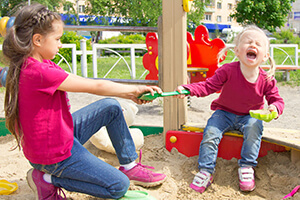Tips for teaching your children to share
Sharing is a necessary and important social skill, but like other skills it must be taught, practiced and learned. It can surprise parents how difficult sharing can be for children, but be assured that the struggle is a normal part of development. The learning process may take several years. To learn to share, a child will need to understand the concepts of “mine and yours”.
A child’s age and temperament also affect sharing. Toddlers especially struggle with sharing as they have very little awareness of others’ feelings, do not understand the idea of “ownership” and are just starting to learn self-restraint and how to act in a social setting. Toddlers tend to be self-centered and assertive, which often leads to conflict over toys, but it is not too early to start laying the foundation for sharing skills.
- Practice waiting. A large part of the sharing process is waiting for a turn. Help your child learn to cope with waiting by choosing another toy, singing a song, taking deep breaths or getting a drink of water. Narrate examples of waiting in your daily family life. “Now we wait while the cookies bake in the oven. You are waiting to use the sink, while your brother finishes brushing his teeth. Mommy is waiting at the red light, because it isn’t her turn to cross the street until the light turns green.”
- Try a variety of strategies. “May I have a turn with the doll? May I have a turn on the swing?” Many times, simply asking for a turn or a chance with a toy will not work, so the child will need to learn to cope with disappointment of the other child refusing to share. “It is hard when your friend won’t share, let’s see if we can find another toy that you’d like to try.” “Your friend is still playing with the truck, but ask your friend when they will be done.”
- Model sharing. “I am enjoying this snack, but I can see that you would like some too. I am going to share some of my crackers with you.” “I am going to give you a turn with the ball. You asked and now I will share by letting you have it.” “Your sister cares about you, and is letting you wear her new headband. It makes you happy when you share, because you can see your sibling or friend enjoying a turn.”
- Use a timer. Being the toy “referee” can be exhausting and it isn’t always clear who should have the toy now, the youngest child, the child using it or the child waiting. Explain in simple terms that today the timer will help us share. The most cooperative child can start with the toy first and play with it for 2-4 minutes (depending on the age of the children). When the timer sounds it means child one’s turn is done and is time to give the toy to the waiting child for their turn. When the timer sounds again, it will be time to give the toy back to child one again (or to child three if there are several children wanting the same toy). If this system doesn’t work, explain to the child that the toy will have to be put on a “time-out” until the group is ready to share.
- Set aside a few “special” toys for the child. A sense of ownership and attachment to people and things is a normal part of development, so it okay to set aside a few special toys just for the child. Some toys are for the group or family, while other toys belong to child and the child can decide whether or not they want to share them. If guests are coming over, you can explain to the child that unless they want to share the special toys with the other children coming, they should put the toys away. If siblings or other children try to play with the “special toys” and your child isn’t feeling willing to share, guard the toys and explain that this is “John’s special toy that he received for his birthday, so we are going to put this away for the time, but you may play with the other toys that are out”.
With time, practice and modeling your child will learn to be generous and that playing cooperatively will bring a more pleasant play or learning experience.
